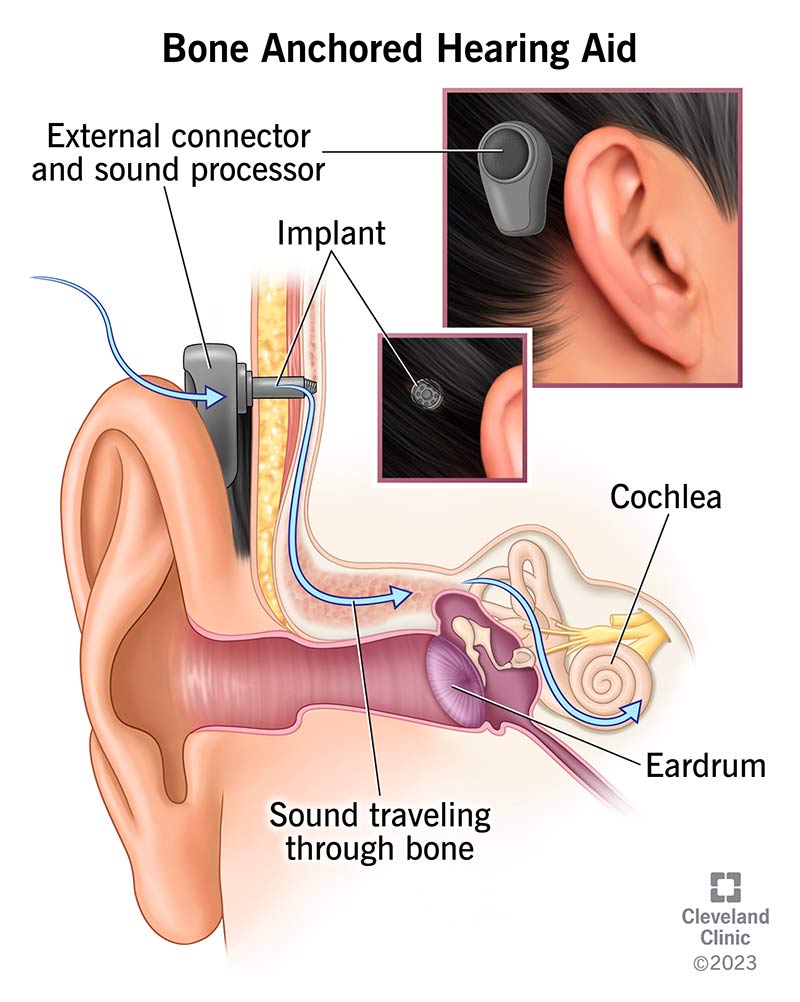Bone-anchored hearing aids (BAHA) are surgically implanted devices that may partially restore hearing for people with certain types of hearing loss. BAHA hearing aids use vibrations through the bones in your skull to send sounds to your inner ear.
Advertisement
Cleveland Clinic is a non-profit academic medical center. Advertising on our site helps support our mission. We do not endorse non-Cleveland Clinic products or services. Policy

Traditional hearing aids amplify sound through your middle ear. In contrast, a bone-anchored hearing aid (BAHA) is a surgically implantable device. It sends soundwaves through the bones of your skull directly into the cochlea (a spiral structure in your inner ear that plays a key role in hearing). Another name for this device is bone-anchored hearing implant (BAI). While BAI is the medically correct term, people use BAHA and BAI interchangeably.
Advertisement
Cleveland Clinic is a non-profit academic medical center. Advertising on our site helps support our mission. We do not endorse non-Cleveland Clinic products or services. Policy
A bone-anchored hearing aid may restore partial hearing in people with certain types of hearing loss or those who aren’t good candidates for traditional hearing aids.
A BAHA traditionally consists of three parts:
There are two main types of bone conduction hearing systems:
Your otolaryngologist (ENT) and audiologist can help determine which option is right for your situation. Bone-anchored hearing aid candidacy depends on several factors, including your age, medical history, type of hearing loss and personal preferences.
Advertisement
During an office visit with your healthcare provider, you can try out a nonsurgical BCHA. This helps you get an idea of how this type of hearing system works before you have surgery.
BAHA hearing aids may work for people with:
These types of hearing loss can result from conditions like:
To find out if you’re eligible for a bone-anchored hearing aid, talk to your healthcare provider. They can refer you to an otolaryngologist for an evaluation.
This type of procedure usually takes between 30 to 60 minutes, depending on the type of bone-anchored hearing system you receive.
During bone-anchored hearing aid surgery, an otolaryngologist will:
Bone-anchored hearing aids rely on osseointegration. During this process, your bone fuses to the titanium implant, providing stability. This fusion must occur before you can attach the sound processor to the external connector. Healing times vary due to the type of BAHA you choose and your body’s healing capacity. But generally, this process takes about one to three months.
Bone-anchored hearing aids offer several advantages, including:
The main disadvantage of bone-anchored hearing aids is that they require surgical placement. BAHA surgery is a minimally invasive procedure. But like all surgeries, it does carry some risk.
Possible complications may include:
Advertisement
In addition, if people with bone-anchored hearing aids sustain head trauma (like a blow to the head), there could be more serious consequences. This could include infection, implant failure or repeat surgery. To reduce your risk for this type of trauma, wear a helmet while playing contact sports or while riding a bike or motorcycle.
Initial recovery takes about three to seven days. During this time, you may have some soreness and redness around the implant site.
You won’t be able to use your BAHA hearing aid right away. You’ll need to wait until your bone fuses to the titanium implant. Once this happens, your provider will attach the external sound processor to your implant and customize the settings to restore your hearing. They’ll also show you how to remove and reattach your processor properly.
BAHA hearing aids offer impressive results. Research studies indicate success rates of 90% or higher.
A BAHA hearing aid sends soundwaves to your inner ear, where the bones in your skull vibrate to help you hear. In contrast, a cochlear implant bypasses your inner ear and directly stimulates your auditory nerve. People who have inner ear damage may benefit from cochlear implants.
Advertisement
Hearing loss can have a significant negative impact on your quality of life. It can feel disappointing and frustrating, especially if you’ve tried traditional hearing aids with limited success. Bone-anchored hearing aids use bone conduction rather than amplification to restore hearing in people with certain ear conditions and types of hearing loss. BAHA devices are minimally invasive and have high success rates. You can choose from several nonsurgical and surgical options, based on your specific needs and preferences. Talk to your otolaryngologist or audiologist to find out if a BAHA is an option for you.
Advertisement
Bone-anchored hearing implants may partially help you hear things around you. Cleveland Clinic’s expert otolaryngology team can help you take the next step.

Last reviewed on 11/21/2023.
Learn more about the Health Library and our editorial process.